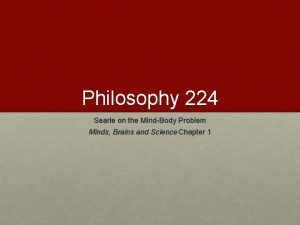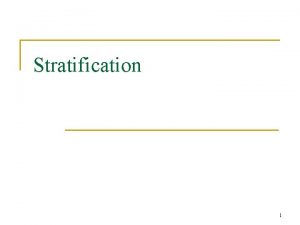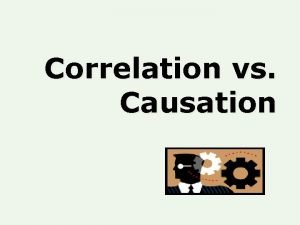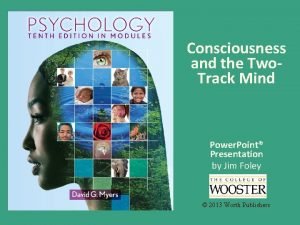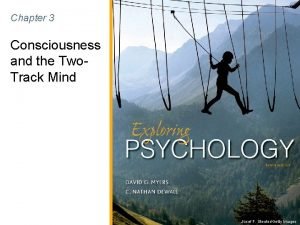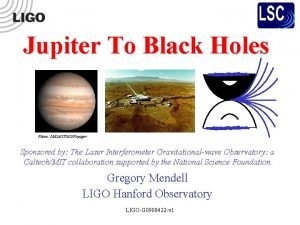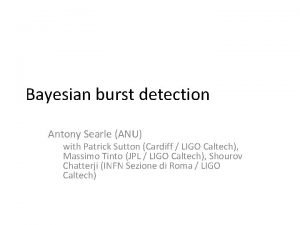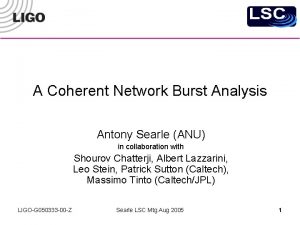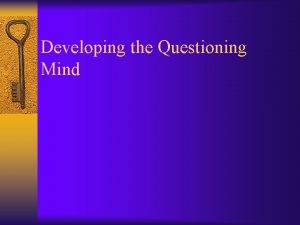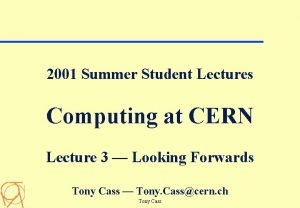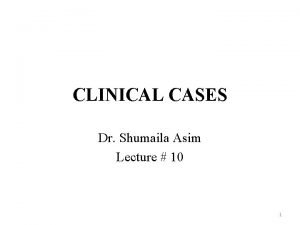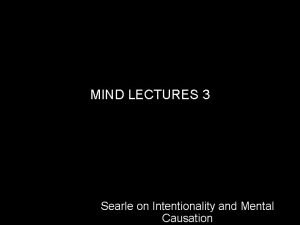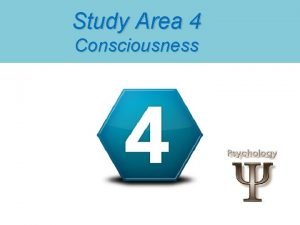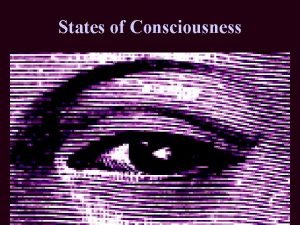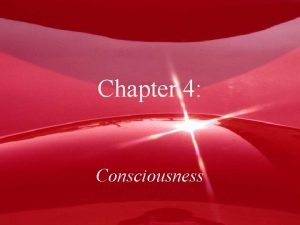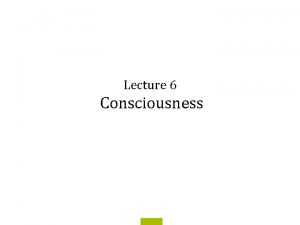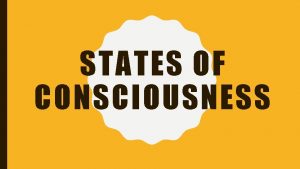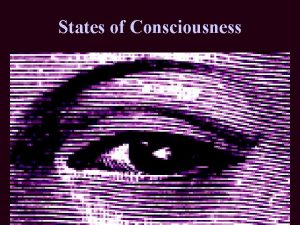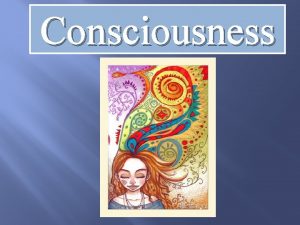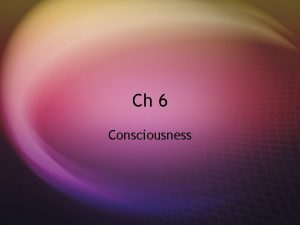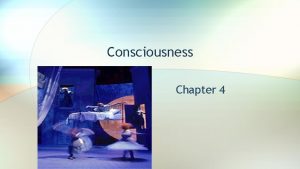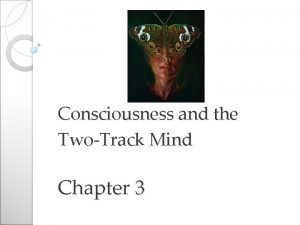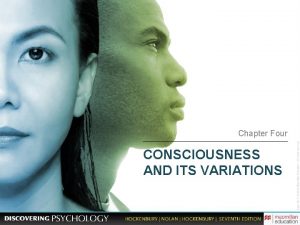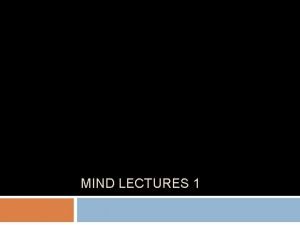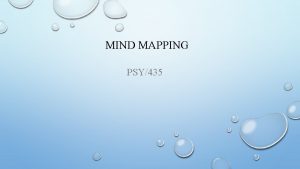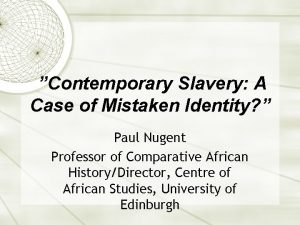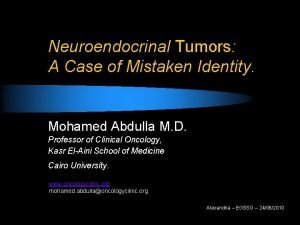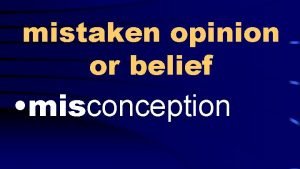MIND LECTURES 2 Searle on Consciousness Four Mistaken



























- Slides: 27

MIND LECTURES 2 Searle on Consciousness

Four Mistaken Assumptions about the Mind – Body Problem The distinction between mental and physical cannot be challenged. Is it true that the mental and physical are opposite categories? 1. The notion of reduction. Are all reductions of the same kind? 1. Causation and Events. Are all causal events asymmetric in time. 1. The transparency of identity. Can we really discover that a mental event is identical to neurophysiological event? 1.

Searle’s Biological Naturalism 1 Conscious states, with their subjective, first-person ontology, are real phenomena in the real world. We cannot provide an eliminative reduction of consciousness, showing that it is just an illusion. Nor can we ontologically reduce consciousness to its neurobiological basis, because such a third-person reduction would leave out the first-person ontology of consciousness.

Searle’s Biological Naturalism 2 Conscious states are entirely caused by lower level neurobiological processes in the brain. Conscious states are thus causally reducible to neurobiological processes. Causally speaking they are not something over and above neurobiological processes. Supervenience is irrelevant. There are two kinds constitutive and causal. Constitutive is not relevant to consciousness and neurobiology. Only causal is.

Searle’s Biological Naturalism 3 Conscious states are realized in the brain as features of the brain system, and thus exist at a level higher than that of neurons and synapses. Individual neurons are not conscious, but portions of the brain system composed of neurons are conscious.

Searle’s Biological Naturalism 4 Because conscious states are real features of the real world, they function causally. My conscious thirst causes me to drink water.

The distinction between the mental and the physical Physical systems do not have to exclude the possibility of having states which are qualitative and subjective. Nothing in an expanded notion of ‘physical’ makes it the case that subjective qualitative states are non-physical. Mental states might not be extended in space, but they are nevertheless located in space and episodic over time.

Reduction Reexamined Causal reduction: A is causally reducible to B only if A has no causal powers over and above the causal powers of B. Ontological reduction: A is ontologically reducible to B only if x’s being an A is just the same as x’s being a B, A = B. A is causally reducible to B does not imply that A is ontologically reducible to B.

Simultaneous causation Some causal events are asymmetric and in time: Billiard Ball A strikes Billiard Ball B and causes B to move. Event X: A striking B caused event Y: B’s moving, to occur. The causal sequence is temporally ordered in the sense that the cause is prior in time to the effect. Some causal events are not asymmetric and ordered in time: Gravity causes a table to stay located on the floor. However, the force of gravity simultaneously and continuously exerts this force while the table stays on the floor as an effect of the force.

Searle against Materialism and Dualism Materialism is the view that the physical world is sufficient for everything that there is. However, it is false since it leaves out subjective qualitative features of human experience. It leaves out the ontology of subjective states. Dualism is problematic since: 1. No one has succeeded in giving an account of how the two realms interact. 2. The postulation of two realms is unnecessary. One can account for both first -person facts and third-person facts without two realms. 3. The postulation creates problems, such as the problem of mental causation.

Searle on the structure of consciousness: Qualitative character = the what it is like feature of consciousness. Many philosophers maintain that only some conscious states have a qualitative character. For example, being in pain does have a qualitative character, but believing that it is going to rain does not have a qualitative character.

Searle on the structure of consciousness: Subjectivity Conscious states are subjective in that they only exists as experienced by a subject, typically human. Ontological subjectivity means the state has a first-person ontology. Epistemic objectivity vs. subjectivity: ‘Jones is six feet tall’ – independent of the feelings and attitudes of anyone – epistemically objective ‘Jones is nicer than Tom’ – dependent on the feelings and attitudes of individuals – epistemically subjective Ontological subjectivity does not imply Epistemic subjectivity.

Searle on the structure of consciousness: Unity Conscious experience is unified in that our conscious experience is in a unified field. We do not experience things as separate and disjoint or as divided between two conscious fields. Conscious experience as unified is a feature of normal functioning brains. It is not a claim about abnormal or degenerate cases of experience. A central question in the philosophy of mind is what explains the unity of conscious experience. In virtue of what is our conscious field bound together as a unity? How do different stimuli bind together to form a unified field?

Searle on the structure of consciousness: Intentionality is the feature of experience whereby the experience is about something. Intentionality is the aboutness or directedness component of experience. Seeing a red chair is having a perceptual experience of a red chair, the experience is directed at and about a red chair. And the content of the experience can be communicated by a proposition: I see a red chair.

Searle on the structure of consciousness: Mood Conscious experience has a flavor or a tone. One finds oneself in various moods. Moods ≠ Emotions, since emotions are necessarily intentional and moods are not necessarily intentional. Moods can predispose us to emotions.

Searle on the structure of consciousness: Center and Periphery A conscious field is susceptible to a distinction between the center and the periphery. Some phenomenon are at the center of my attention. And others are at the periphery, but are such that they can be brought to the center. One’s attention brings things into the center and out of the periphery.

Searle on the structure of consciousness: Pleasure & Unpleasure Conscious experience always comes along with some pleasure or unpleasure. Conscious states can be evaluated along a spectrum of pleasure and non-pleasure. Question: are any conscious states purely neutral?

Searle on the structure of consciousness: Situatedness Conscious experience always comes against the background of a situation, which may not be one’s point of focus, but which informs and structures their conscious experience. The situatedness and background is not part of the center of focus. Certain facts that structure the background can be brought to the center of attention.

Searle on the structure of consciousness: Active and Passive Consciousness Some conscious experience involves the experience of volition or agency. Some conscious experience involves the experience of passivity and non-agency. The distinction is not sharp, but there are clear cases of active and passive aspects of conscious experience. Perception has active components, but is experienced, generally, as passive.

Searle on the structure of consciousness: Gestalt Structure: I

Searle on the structure of consciousness: Gestalt Structure: II

Searle on the structure of consciousness: Gestalt Structure: II Our experience is organized. It can be organized in different ways. Sometimes in our experience we fill in details to make something that looks like one thing appear more like something else. There is a figure – ground structure to our conscious experience.

Searle on the structure of consciousness: Sense of Self Conscious experience comes along with a sense of self. A sense of who one is. Conscious experience presupposes a subject. Question: what is the nature of the self that is the subject of conscious experience. Does consciousness presuppose a substantial self that is numerically identical over time.

Two views on consciousness: Mysterianism Contingent mysterianism: explaining consciousness in terms of current resources is a mystery. We don’t have a good understanding of how physical states can cause physical subjective qualitative states, or how mental states that are non-physical could cause physical states. Necessary mysterianism: consciousness cannot be explained because of a fundamental explanatory gap between the physical and the phenomenal that cannot be crossed because of the structure of our concepts.

Two views on consciousness: Panpsychism is the view that everything at the fundamental level is conscious, and thus there is no problem of how consciousness comes out of the fundamental level of reality. Problem: Even if everything at the fundamental level is conscious, we still have a further question – How do little bits of consciousness compose together to form conscious experience? Are there any laws that govern when a composition of conscious parts constitutes a composite of consciousness?

Two Approaches to Studying Consciousness: Building Block Approach: find out the neural correlates of individual conscious experiences, such as perception or taste. Avoid looking at the whole conscious field. Instead study degenerate cases. Blindsight: Damage to visual area 1, they are blind in a certain area of the visual field, but they can act in response to the blindness with action that is appropriate. Such as grasping at what is absent in the damaged area of the visual field. Binocular Rivalry: Right eye vertical lines, Left eye horizontal lines. No grid at conscious level, instead switching back and forth. Locate the point where the switching occurs.

Two Approaches to Studying Consciousness: Unified Filed Theory Approach Unified Field Approach: The whole field of consciousness is the area of investigation, not a simple quale of redness in the field. Subjectivity in the whole field is what is relevant. Main distinction: Don’t ask: How does the brain produce a simple quality of perception, such as a red quale, which is a building block of consciousness? Instead ask: How does the brain produce the whole unified field of subjective consciousness?
 Searle mind body problem
Searle mind body problem Types of social mobility
Types of social mobility Causation vs correlation
Causation vs correlation Two track brain
Two track brain Consciouness
Consciouness Margaret marcus
Margaret marcus Searle
Searle Antony searle
Antony searle Antony searle
Antony searle Searle froid
Searle froid Searle and associates
Searle and associates Taxonomia de searle
Taxonomia de searle Mindmap master
Mindmap master A wandering mind is an unhappy mind
A wandering mind is an unhappy mind A questioning mind
A questioning mind Reinforcement learning lectures
Reinforcement learning lectures Recursive fractals c++
Recursive fractals c++ Power system lectures
Power system lectures Cern summer school lectures
Cern summer school lectures Dr sohail lectures
Dr sohail lectures Data mining lectures
Data mining lectures Rcog eportfolio
Rcog eportfolio Theory of translation lectures
Theory of translation lectures Jim kurose umass
Jim kurose umass Rbc formation stages
Rbc formation stages Frcr physics lectures
Frcr physics lectures Hugh blair lectures on rhetoric
Hugh blair lectures on rhetoric Dr asim lectures
Dr asim lectures
